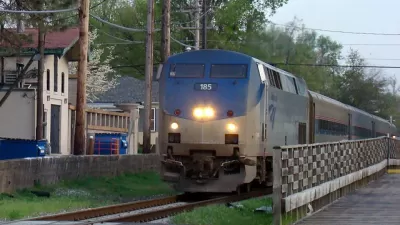The speedometer on the Chicago to St. Louis train hit 110 mph - and stayed there for five minutes, but it was enough to elevate the spirits of Transportation Secretary Ray LaHood and the other dignitaries on-board. Normal speeds top out at 79 mph.
The Associate Press' Jason Keyser reports on a symbolic Oct. 19 Amtrak ride that served as a morale-lifter for the Midwest's high speed rail advocates. The higher speed of 110 mph will become the norm for most of the route by 2015. This was the first time that Amtrak traveled that fast on any Midwestern route. Due to shared trackage with freight trains, it is not expected that speeds will go surpass 110 mph.
While the Northeast Corridor has its high-speed Acela train (see Eric Jaffe's Oct. 19 article on the 5% increase in Amtrak ridership in September over last year in this corridor that includes the Northeast Regional train in the Atlantic Cities) and California has it's embattled San Francisco-Los Angeles project designed to reach 220 mph, the Midwest has not received as much attention as high speed rail on the coasts. In fact, most publicity arose due to the rejection of the high speed rail grants included in President Obama's 2009 Recovery Act (stimulus funding) by Ohio Gov. John Kasich and Wisconsin Governor Scott Walker.
"Four years ago we were nowhere. Illinois and the country was a wasteland when it came to high speed rail," said U.S. Transportation Secretary Ray LaHood. "This is a dream come true today." Also on-board was Illinois Gov. Pat Quinn and other politicians and transportation officials and rail advocates, including Richard Harnish, director of the Midwest High Speed Rail Association.
"The improved Amtrak service in the Chicago-St. Louis corridor signals a genuine commitment to faster, safer, and cleaner travel", stated Harnish.
Not all in Illinois are advocates of the higher speed train service though. Kristina Rasmussen, vice president of the llinois Policy Institute, expressed doubts about the line's ability to break-even due in part to political pressure to keep fares low.
"We're yoking ourselves to trains that will obligate taxpayers to provide billions of dollars in future subsidies," she said.
FULL STORY: Illinois Amtrak Train Set To Hit 110 Mph In Test Run

Planetizen Federal Action Tracker
A weekly monitor of how Trump’s orders and actions are impacting planners and planning in America.

Chicago’s Ghost Rails
Just beneath the surface of the modern city lie the remnants of its expansive early 20th-century streetcar system.

San Antonio and Austin are Fusing Into one Massive Megaregion
The region spanning the two central Texas cities is growing fast, posing challenges for local infrastructure and water supplies.

Since Zion's Shuttles Went Electric “The Smog is Gone”
Visitors to Zion National Park can enjoy the canyon via the nation’s first fully electric park shuttle system.

Trump Distributing DOT Safety Funds at 1/10 Rate of Biden
Funds for Safe Streets and other transportation safety and equity programs are being held up by administrative reviews and conflicts with the Trump administration’s priorities.

German Cities Subsidize Taxis for Women Amid Wave of Violence
Free or low-cost taxi rides can help women navigate cities more safely, but critics say the programs don't address the root causes of violence against women.
Urban Design for Planners 1: Software Tools
This six-course series explores essential urban design concepts using open source software and equips planners with the tools they need to participate fully in the urban design process.
Planning for Universal Design
Learn the tools for implementing Universal Design in planning regulations.
planning NEXT
Appalachian Highlands Housing Partners
Mpact (founded as Rail~Volution)
City of Camden Redevelopment Agency
City of Astoria
City of Portland
City of Laramie



























